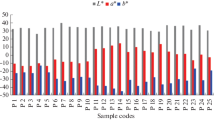Abstract
The present study reports the effect of the fuels: glycine, urea, and citric acid on the optical properties of ceramic pigment Zn0.5Cu0.5Cr2O4, synthesized by solution combustion. The powders were characterized by X-ray diffraction, which showed the formation of the expected phases. Scanning electron microscopy (SEM) was also used, and the images showed the formation of agglomerates and porous samples. Finally, VIS-spectroscopy, and CIEL*a*b* color-measurements showed the powders are black. The results demonstrated that the synthesis by the combustion reaction was very fast and safe, and that the heat released in the combustion reaction is a function of fuel, releasing more heat with glycine, and less with citric acid. It was observed that the powder is more black with urea and citric acid that with glycine. The optical properties showed that the powders could be used as ceramic pigments.
Access this chapter
Tax calculation will be finalised at checkout
Purchases are for personal use only
Preview
Unable to display preview. Download preview PDF.
Similar content being viewed by others
References
M. Llusar et al., “Synthesis and coloring performance of Ni-geikielite (Ni,Mg)TiO3 yellow pigments: Effect of temperature, Ni-doping and synthesis method,” Journal of the European Ceramic Society, 35 (13) (2015), 3721–3734.
C. Provisions, “Classification and chemical descriptions of the complex inorganic color pigments” (Report CPMA/Color Pigments Manufacturers Association, 2013).
L. Desouza et al., “Blue pigments based on CoxZn1-xAl2O4 spinels synthesized by the polymeric precursor method,” Dyes and Pigments, 81 (3) (2009), 187–192.
M. Llusar et al., “Stability and coloring properties of Ni-qandilite green spinels (Ni,Mg)2TiO4: the half color wheel of Ni-doped magnesium titanates,” Dyes and Pigments, 122 (2015), 368–381.
M. Blosi et al., “Au-Ag nanoparticles as red pigment in ceramic inks for digital decoration,” Dyes and Pigments, 94 (2) (2012), 355–362.
H.E. Sadek et al., “Nano Mg1-xNixAl2O4 spinel pigments for advanced applications,” Spectrochimica Acta Part A: Molecular and Biomolecular Spectroscopy, 125 (2014), 353–358.
M. Jovaní et al., “Pigments based on Cr and Sb doped TiO2 prepared by microemulsionmediated solvothermal synthesis for inkjet printing on ceramics,” Dyes and Pigments, 116 (2015), 106–113.
T.S. Lyubenova, J.B. Carda, and M. Ocaña, “Synthesis by pyrolysis of aerosols and ceramic application of Cr-doped CaYAlO4 red–orange pigments,” Journal of the European Ceramic Society, 29 (11) (2009), 2193–2198.
I. Mindru et al., “Copper aluminate spinel by soft chemical routes,” Ceramics International, In press (2015).
S. Mestre, M.D. Palacios, and P. Agut, “Solution Combustion Synthesis of (Co,Fe)Cr2O4 pigments,” Journal of the European Ceramic Society, 32 (9) (2012), 1995–1999.
Y. Zhang et al., “Preparation and characterization of pyrochlore oxide Y2Ti2O7 nanocrystals via gel-combustion route,” Ceramics International, 40 (4) (2014), 5223–5230.
Annelise Alves, Carlos Bergmann, and Felipe Berutti, Novel Synthesis and Characterization of Nanostructured Materials (Berlin: Springer-Verlag Berlin Heidelberg, 2013), 78.
K.C. Patil et al., Chemistry of nanocrystalline oxide materials combustion synthesis, properties and applications (Singapore: World Scientific Publishing Co. Pte. Ltd, 2008), 337.
M.C. Merino et al., “Combustion Syntheses of CoAl2O4 Powders Using Different Fuels,” Procedia Materials Science, 8 (2015). 519–525.
Author information
Authors and Affiliations
Editor information
Editors and Affiliations
Rights and permissions
Copyright information
© 2016 TMS (The Minerals, Metals & Materials Society)
About this chapter
Cite this chapter
Miranda, E.A.C., Carvajal, J.F.M., Sepúlveda, A.A.L., Gutierrez, J.C.R., Baena, O.J.R. (2016). Properties of Ceramic Pigment Zn0.5Cu0.5Cr2O4 Synthesized by Solution Combustion Method. In: Ikhmayies, S.J., et al. Characterization of Minerals, Metals, and Materials 2016. Springer, Cham. https://doi.org/10.1007/978-3-319-48210-1_91
Download citation
DOI: https://doi.org/10.1007/978-3-319-48210-1_91
Publisher Name: Springer, Cham
Print ISBN: 978-3-319-48623-9
Online ISBN: 978-3-319-48210-1
eBook Packages: Chemistry and Materials ScienceChemistry and Material Science (R0)




